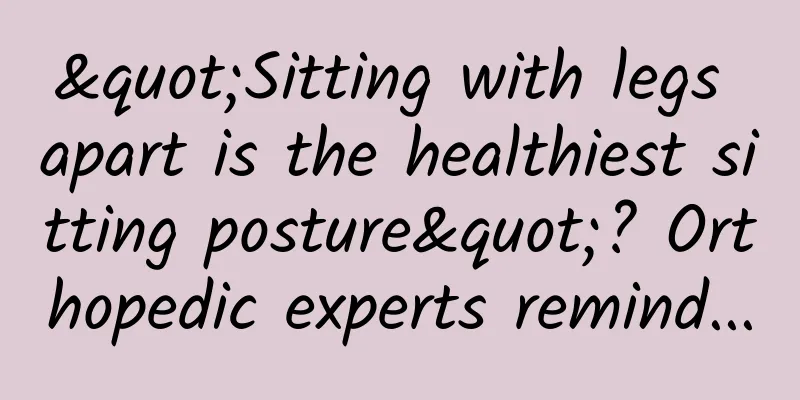"Sitting with legs apart is the healthiest sitting posture"? Orthopedic experts remind...

|
"Sitting with legs apart" is an indecent sitting posture that is often complained about by everyone. A random shot taken on the subway one day. Image source: Photo taken by the editor But some time ago, there was a very popular saying on the Internet that sitting with legs apart is the healthiest sitting posture, because it can better maintain the neutral spine. The picture comes from the Internet Does this make sense? What is the correct way to sit? Correct sitting posture There is only one key Let's do a test first. Please choose the correct sitting posture in your opinion in the following picture: Image source: Reference [1] The above image is from a study on "Physiotherapists' perceptions of optimal sitting and standing postures." This review surveyed 544 Greek physiotherapists to investigate their views on the optimal standing and sitting postures, and how they describe and quantify postural characteristics and the best posture. 97.5% of physiotherapists chose postures 2, 4, and 5, of which nearly half (41.4%) chose posture 2 - the lumbar spine is in a lordotic state, the thoracic spine is in a slightly kyphotic state, the pelvis, head and shoulders are in a straight line, and the chin is moderately retracted. This posture is consistent with the physiological curvature of the human spine. In fact, the key to a correct sitting posture is to keep the spine perpendicular to the horizontal plane, and it has little to do with whether the legs are crossed or not. This posture will not put too much pressure on the spine and prevent the spine from being in an abnormal curvature due to excessive pressure. 4 steps to find a healthy sitting posture 1. Find the sitting bones Touch your buttocks and find two hard bones. These are our ischial tuberosities, which are the main force-bearing areas when sitting and can transfer gravity downward. Thin people can easily feel them, while people with more flesh can sit down and feel the pressure of the two bones. The force on both sides should be consistent, not biased to one side. 2. Determine the position of the hip and knee joints The knee and hip joints should be at a 90-degree right angle, and the feet should be flat on the ground. The angle of the legs should vary according to the physique of the person. Remember not to bend too much inward or too far outward, and it is best to keep the feet shoulder-width apart. 3. Maintain the curve of the spine Remember the directions of the four curves of the human spine in the picture. Feel it yourself, with your upper body upright, your waist as far forward as possible, your chest slightly convex, your head raised but your chin slightly retracted. Adjust the position of the computer screen according to the direction of your sight, and avoid leaning forward, lowering your head, and other bad movements. Correct sitting posture. Copyright image from the gallery, reprinting and using may cause copyright disputes 4. Finally, check whether the head, shoulders and hips are in a vertical line. Ideally, your ears should be aligned with your shoulders. Lower your shoulders and keep your head, shoulders, and hips in a vertical line. This will help eliminate tightness in your shoulders and relieve shoulder and back pain caused by sitting for a long time. It takes time to get the correct sitting posture. It may not be 100% correct now, but if this article can attract everyone's attention, avoid wrong sitting posture, and achieve correct sitting posture as much as possible, our goal will be achieved~ Don't make these sitting mistakes again 1. Cross your legs Crossing your legs can cause the pelvis to tilt and the lumbar spine to be unevenly compressed, which can lead to scoliosis over time. Long-term compression of blood vessels can lead to blood circulation disorders, varicose veins in the lower limbs or vascular embolism. Long-term compression of the medial compartment of the knee joint can damage the cartilage and increase the risk of osteoarthritis. 2. Sit with your waist suspended This posture of "lying down" on a chair may seem relaxing, but it is actually quite harmful. The waist is suspended in the air, and the thoracolumbar spine is kyphotic, which will increase the load on the waist, causing damage to the muscles on the back of the waist, and even lumbar disc herniation. In addition, the main focus of this posture is on the sacrum (the root of the tail), which is prone to sacrum pain. 3. Sit with your body leaning forward When you sit with your body leaning forward, the muscles in your lower back will pull on your torso like a taut bowstring. Long-term and continuous contraction and force will cause pain and spasm in the lower back muscles. 4. "Ge You Lying Down" There are few people who have not done the "Ge You lying posture". However, the harm this comfortable posture brings to our body should not be underestimated. The reason why this movement feels comfortable is that the muscles of the waist and neck do not need to be exerted. The back is suspended in the air. The spine is in an unbalanced state in this posture, the whole body sinks, and the central axis moves backward, which can easily cause cervical spondylosis, lumbar disc herniation, and even spinal deformity. 5. Keep your head up and your chest out This posture may surprise many people. The correct sitting posture that we have believed since childhood may not be that scientific. Because our thoracic spine is physiologically convex, if we stick out our chest too much, it will reduce the normal physiological curvature. Copyright images in the gallery. Reprinting and using them may lead to copyright disputes. Finally, I would like to remind everyone that sitting for a long time is not beneficial regardless of whether your sitting posture is correct or not. It is recommended that you stand up and move around for 5-10 minutes every hour you sit. References 1. Vasileios Korakakisa, Kieran O'Sullivanb, Peter B. O'Sullivane, et al. Physiotherapistperceptionsofoptimalsittingandstandingposture.MusculoskeletSciPract.2019:39:24-31. Author: Ji Gang, deputy chief physician of orthopedics, First Hospital of Hebei Medical University Reviewer: Tang Qin, Director and Researcher of the Science Popularization Department of the Chinese Medical Association |
<<: Why do sandstorms always occur in spring?
Recommend
What are the functions of snow lotus?
I believe everyone is familiar with snow lotus, b...
Can Huangjing be soaked in water and drunk?
In traditional Chinese medicine, there are many C...
Can you subdue a crocodile by pinching its mouth with one hand? Why don't you go to heaven!
What? Last time there was a news report about a c...
What Chinese medicine can nourish the kidney?
Many people in life often feel weak kidney yang, ...
The efficacy and function of nail beads
Many people choose to take supplements to make th...
Genetic lottery! Pear-shaped sisters stand up, these benefits you dare not think about
Review expert: Shen Yingjian, Director of the Nut...
Why is gold, a precious metal, so valuable? | Science Gallery
Creator: China Digital Science and Technology Mus...
Young people are the biggest victims of depression! Experts call for global action
Written by: Wang Haha Layout: Li Xuewei It is est...
General leaf efficacy and function
The effects and functions of General Leaf are coo...
In the universe, a giant structure that shouldn't exist was discovered
In 2021, Alexia M. Lopez was pursuing a graduate ...
The efficacy and function of evergreen grass
When it comes to evergreen grass, we are all fami...
"Swallow roundworm eggs and let them grow in your body": AI's weight loss advice is sometimes too unreliable
At present, a worrying phenomenon is gradually em...
Effects and functions of plant gold
Polygonatum sibiricum is an uncommon plant, but i...
Species Exploration: What are those strange creatures in "Longling Mystery Cave"?
Author: Zhao Xumao The article comes from the Sci...
He just renovated a lighthouse, so why was he awarded the Nobel Prize this year?
In 1912, the Royal Swedish Academy of Sciences de...









